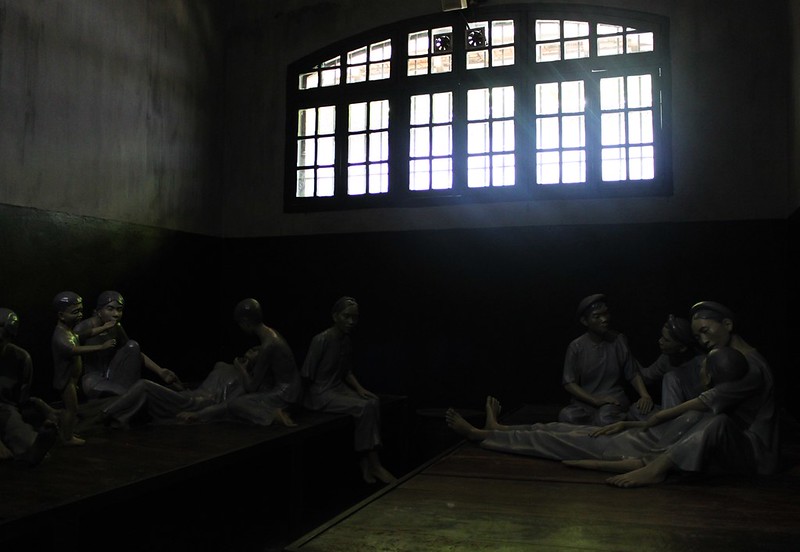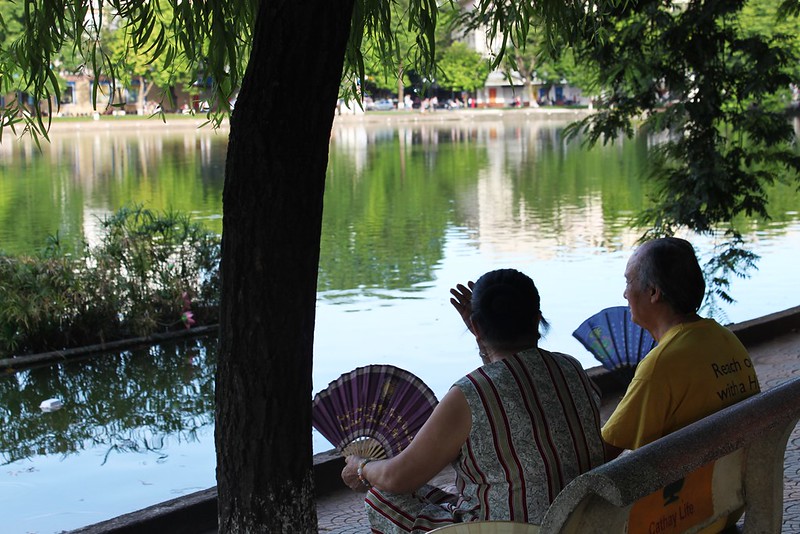Two and a half years ago, I was watching, transfixed, American snipers dropping bombs on hospitals in Vietnam in a video clip at Hanoi's Hoa Lo prison. At that time, Israel was dropping bombs on schools in Gaza, and I remember thinking that years from now, there would be a museum somewhere playing video clips of that massacre, because history never stops repeating itself no matter how many times its destruction is documented.
I visited Hoa Lo by myself
– sans the new friends I'd managed to make on the second day of my trip – and perhaps the experience was made far more profound because of this. Hoa Lo was sparser than Hanoi's other museums, and a thick silence pervaded it. What we see today is only a small part of what was the largest prison in Indochina, where French colonisers kept and punished Vietnamese political prisoners, and where later Vietnam imprisoned American prisoners of war (who dubbed it "Hanoi Hilton", though the museum amusingly – and, well, obviously – ignores this irony).
There's a plan of how the prison was, and art and sculptures pertaining to war and death in the courtyard. In the large chambers are models of prisoners with various postures and expressions, chains at their feet, so lifelike in the dim light that it's hard to not believe they haven't been simply frozen in time.
Despite its impact, I don't mean to imply that the museum is without its problems – I once spoke of such museums as having a curatorial "agenda" – and it's pretty clear how we're meant to think about it. They are also always tied to nationalism and official state discourses, and are not prone to nuance (though I'd be interested in hearing about exceptions). Read an interesting essay on the museum here.
 |
| Inside Hoa Lo prison |
***
It began with a bridge.
I couldn't quite tell you why I zeroed in on Hanoi for my solo trip from Singapore two years ago, but my travel inspiration tends to be pretty impulsive. All I remember is browsing photographs of a bright red bridge and thinking "I've got to see that," and the next thing I knew (after lots of research, of course), I'd booked a return ticket. The visa was a different story. Apparently Indians had not cottoned on to how cool Vietnam is, because travel agencies had no clue. The embassy asks you to apply for a formal visa that takes time, but there was, in fact, a slightly offbeat visa-on-arrival option
– and by offbeat, I mean you had to pay a small fee online to get your name onto an approval letter (along with a bunch of other tourists), and only once you had this letter would you be allowed to board a plane.
Two days before I was scheduled to leave, I was to be found phoning hotels to make sure they were legit because I had never seen this many tiny, cheap but well-rated hotels on my usual trusted websites than I did for Hanoi. Being a solo traveller means I have to be slightly obsessive about safety, and though each time I find myself loosening up the rules a little, arriving in an unfamiliar country without a place to stay isn't my kind of adventure. (I did experience that once in London, and let's just say having a guaranteed roof over your head isn't overrated).
 |
| In the Ngoc Son temple complex |
So there I was at the small and clean Hanoi airport, standing in the barely-there visa queue. The actual visa cost me 1,000,000 VND and a reproachful look for not carrying US dollars from the official who typed out this large number for me on a calculator. The process was quick, and once I'd located my ride (a handmade sign that read "Ms. Kriti" in blue felt tip), I found myself in the old-ish "cab" arranged by my ho(s)tel Koto, zipping through the Vietnamese capital, my life in the hands of an adolescent driver with whom I communicated solely in sign language (he had to gesture twice that I should stop walking. I guess I was jumpy). I didn't get kidnapped, however, despite all the warnings from locals and tourists alike about the tout cabs that con people regularly, and in my room I reflected that perhaps travel makes you stronger by making you vulnerable, because this city sure was overwhelming. I didn't entirely succumb to panicked beginning-of-adventure feelings (oh my GOD, why did you do this to yourself again?!), and decided, matter-of-factly, to go on a quest for lunch, which ended quickly when I found a semi-hygienic place and proceeded to order the same food I'd been eating for the last few days. At least there was wi-fi. Even the tiniest outdoor street food set-up in Hanoi comes with free wi-fi. Delhi, take note.
It was all up from there. Not only did I succeed in finding lake Hoan Kiem with its red, red bridge by following a map and some German-speaking tourists, I also spotted, at the busy shopping center opposite, a large hoarding with three familiar letters: KFC. That's when I truly knew I was going to be fine. Hey, don't judge me. I had my share of ph
ở and rice noodles and goat meat, but as they say, never underestimate the familiar in an unfamiliar city.
 |
| Beating the heat by lake Hoan Kiem |
The thing is, though, that Hanoi is a lot like Delhi. There's the same mass of electrical wires like in Old Delhi, Hoan Kiem smells like the Hauz Khas lake and looks like inferi will pull you under, and while crossing roads seemed slightly more daredevil, I caught myself more than once saying, "You're Indian. This is what we do." But people hardly honk, aren't aggressive, there are tons of women on scooters, no one stares at you irrespective of what you wear, the kids look happy all the time, you're offered a glass of water upon entering any place, and the rickshaws ('cyclos' in localspeak) are backwards; okay, maybe it's not that much like Delhi. I decided later that Hanoi was not one of my favourite places, but definitely one of my favourite experiences.
 |
| The crossing |
 |
| A vendor in Hanoi Old Town. Those things are heavy, as I found out when one was playfully placed on my shoulder. A moving short film at the Vietnamese Women's Museum about these mostly migrant vendors who come to Hanoi to earn money but have to be separated from their families brought tears to my eyes. That didn't stop me from bargaining for bananas. |
***
Remnants of Vietnam's past are everywhere: in the French colonial architecture, in the mausoleum dedicated to Ho Chi Minh, in the coexistence of the dong and the dollar
– the latter because of how important tourism is to this country, with tourists from certain parts of the world being given special treatment everywhere (one guess: it's not India).
 |
| Hanoi's French Quarter |
There was no time for boredom, but plenty for leisure. The French Quarter and the area around lake Hoan Kiem offer strolling opportunities. The museums are glorious and interactive, even eccentric; I was very impressed with those I did see, and suspect that we could learn a lot from them (the Ho Chi Minh Museum and the Vietnamese Women's Museum, and, of course, Hoa Lo, to name just three). There are pagodas, (polluted) lakes, a famous water puppet theatre show, Vietnam's first national university, and travel agencies around every corner competing for the best deals to take you to nearby provinces.
 |
Tran Quoc pagoda, dating back to the sixth century, located by the West Lake. This is the oldest Buddhist temple in Hanoi, still bustling, and with an impressive shrine indoors.
|
 |
The Presidential Palace and other quarters are also located within the Ho Chi Minh Mausoleum complex, as well as a small lake and mango groves.
|
 |
Still within the Palace compound
|
 |
Thang Long Water Puppet Theatre: the orchestra
|
 |
| Water puppetry is a centuries-old art in Vietnam with many different styles of puppets, including hand and shadow puppets as well as kites and even fire. |
Then there were the people. The Welsh girl fresh out of law school who paid to kayak with me in Ha Long Bay because I was too chicken to go alone. The German who smiled at me as we ate breakfast at adjacent tables and with whom I spent a day exploring Hanoi. The group of 30-year-old Italians in Tam Coc who had been friends since their school days and take annual trips together but didn't mind adopting me for a day so I wouldn't feel alone as we gorged on goat meat and were rowed in a boat across the rice fields. The Finnish lady with the heartiest sense of humour with whom I shared a cab to the airport and a coffee, and who taught me the value of friendship. The tall, athletic, perfect, movie star-like couple that I never spoke to but encountered no less than four times at various locations during my trip, including at the airport; I was too intimidated to ever say hi – they looked like those people that never sweat while I was forever dying for a shower – but I could swear that the final time, just before we boarded different planes, the woman pointed me out to the man.
 |
| Being rowed through Tam Coc's lush rice fields |
 |
| Boats in Ha Long Bay |
 |
| Ha Long Bay, a UNESCO World Heritage site. Our guide showed us where one of the James Bond movies was shot, but I can't remember which one. I mean, it's a James Bond movie. |
And one night, at Hanoi's famous weekend night market, three girls from different countries sharing a meal and saying how grateful they were to have met each other because otherwise they would have been in their hotel rooms all evening. I guess some fears have no boundaries.
On my way back to Singapore, as I stared out at the reddening sky through the airplane window, grateful and satisfied, I realised that being solitary is infinitely preferable to being surrounded by people who don't understand why you care about things that happened many years ago or are happening thousands of miles away. And for the lonely moments, there are thoughts, but there are also a vast number of wanderers in this world that we are yet to meet.
 |
| The red bridge at lake Hoan Kiem, leading to the Ngoc Son temple. |















You are an insanely good photographer. What a beautiful and satisfying travelogue. I want to plan my trip to Vietnam right away, but in case I don't make it right away, this will see me through for now.
ReplyDelete